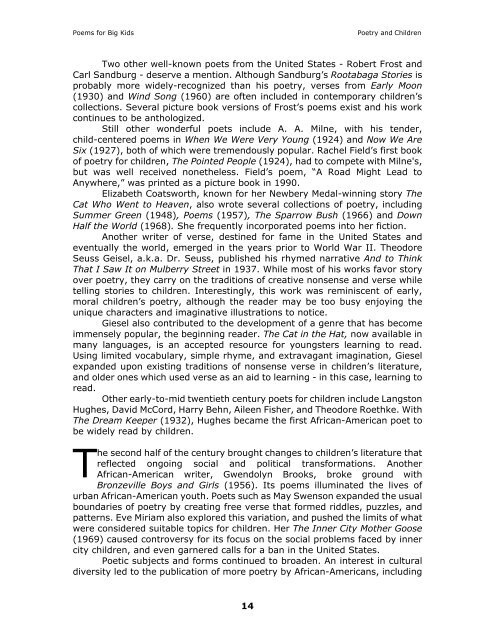Create successful ePaper yourself
Turn your PDF publications into a flip-book with our unique Google optimized e-Paper software.
<strong>Poems</strong> <strong>for</strong> <strong>Big</strong> <strong>Kids</strong> Poetry and Children<br />
Two other well-known poets from the United States - Robert Frost and<br />
Carl Sandburg - deserve a mention. Although Sandburg’s Rootabaga Stories is<br />
probably more widely-recognized than his poetry, verses from Early Moon<br />
(1930) and Wind Song (1960) are often included in contemporary children’s<br />
collections. Several picture book versions of Frost’s poems exist and his work<br />
continues to be anthologized.<br />
Still other wonderful poets include A. A. Milne, with his tender,<br />
child-centered poems in When We Were Very Young (1924) and Now We Are<br />
Six (1927), both of which were tremendously popular. Rachel Field’s first book<br />
of poetry <strong>for</strong> children, The Pointed People (1924), had to compete with Milne's,<br />
but was well received nonetheless. Field’s poem, “A Road Might Lead to<br />
Anywhere,” was printed as a picture book in 1990.<br />
Elizabeth Coatsworth, known <strong>for</strong> her Newbery Medal-winning story The<br />
Cat Who Went to Heaven, also wrote several collections of poetry, including<br />
Summer Green (1948), <strong>Poems</strong> (1957), The Sparrow Bush (1966) and Down<br />
Half the World (1968). She frequently incorporated poems into her fiction.<br />
Another writer of verse, destined <strong>for</strong> fame in the United States and<br />
eventually the world, emerged in the years prior to World War II. Theodore<br />
Seuss Geisel, a.k.a. Dr. Seuss, published his rhymed narrative And to Think<br />
That I Saw It on Mulberry Street in 1937. While most of his works favor story<br />
over poetry, they carry on the traditions of creative nonsense and verse while<br />
telling stories to children. Interestingly, this work was reminiscent of early,<br />
moral children’s poetry, although the reader may be too busy enjoying the<br />
unique characters and imaginative illustrations to notice.<br />
Giesel also contributed to the development of a genre that has become<br />
immensely popular, the beginning reader. The Cat in the Hat, now available in<br />
many languages, is an accepted resource <strong>for</strong> youngsters learning to read.<br />
Using limited vocabulary, simple rhyme, and extravagant imagination, Giesel<br />
expanded upon existing traditions of nonsense verse in children’s literature,<br />
and older ones which used verse as an aid to learning - in this case, learning to<br />
read.<br />
Other early-to-mid twentieth century poets <strong>for</strong> children include Langston<br />
Hughes, David McCord, Harry Behn, Aileen Fisher, and Theodore Roethke. With<br />
The Dream Keeper (1932), Hughes became the first African-American poet to<br />
be widely read by children.<br />
The second half of the century brought changes to children’s literature that<br />
reflected ongoing social and political trans<strong>for</strong>mations. Another<br />
African-American writer, Gwendolyn Brooks, broke ground with<br />
Bronzeville Boys and Girls (1956). Its poems illuminated the lives of<br />
urban African-American youth. Poets such as May Swenson expanded the usual<br />
boundaries of poetry by creating free verse that <strong>for</strong>med riddles, puzzles, and<br />
patterns. Eve Miriam also explored this variation, and pushed the limits of what<br />
were considered suitable topics <strong>for</strong> children. Her The Inner City Mother Goose<br />
(1969) caused controversy <strong>for</strong> its focus on the social problems faced by inner<br />
city children, and even garnered calls <strong>for</strong> a ban in the United States.<br />
Poetic subjects and <strong>for</strong>ms continued to broaden. An interest in cultural<br />
diversity led to the publication of more poetry by African-Americans, including<br />
14



